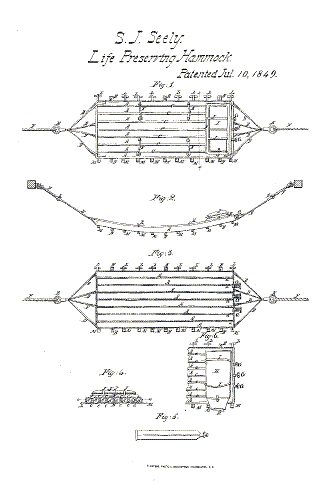1849 SEELY Life Preserving Hammock Patent 8874
- N. PETERS PHOTO-LITHOGHAPHEH. WASHINGTON D.C.
- UNITED STATES PATENT OFFICE.
- SAMUEL J. SEELY OF NEW YORh N. Y.
- ARRANGEMENT OF THE SECTIONS IN LIFE-PRESERVING HAMMOCKS.
- Specification of Letters Patent No. dated July 10 1849
To all whom it may concern:
Be it known that I SAMUEL J. SEELY of the city county and State of New York have invented a new and useful Hammock called Seely’s Life-Preserving Hammock which is described as follows reference being had to the annexed drawings of the same making part of this specification.
Figure 1 is a birdseye view of the ham-mock. Fig. 2 is a side elevation. Fig. 3 is a horizontal section on the line o o of Fig. 4. Fig. 4 is a vertical transverse section on the line x x of
Fig. 1. Fig. 5 is a plan of a pouch for containing water. Fig. 6 is a sectional view showing part of the hammock and the provision pouch open. Similar letters in the several figures refer to corresponding parts.
This invention and improvement consists in the construction of a hollow sectional air tight hammock of india rubber cloth to be inflated with air and provided with a provision pouch pillow water pouch inflating tubes and valves loop% and toggles slings thimbles lanyards and other appendages by which it is made to serve the purposes of hammock mattress and in case of ship wreck as a life preserver—also as a canoe and ponton for the support of a bridge—raft for the removal of cargoes from stranded ships barricades against the small shot of the enemy during an action and for other purposes.
This hammock is composed of a series of parallel longitudinal air tight chambers A of stout india rubber cloth united together at their sides by a durable water proof composition or cement and stayed by a. number of nonelastic transverse strips or bands B of the same material also cemented or other-wise secured to the external surface of the aforesaid chambers which chambers may be in the form of cylinders when inflated which is found to be the strongest and best form although other forms may be used and the bands or strips B are extended beyond the sides of the two outside chambers and formed into strong loops by which the hammock may be suspended to hooks inserted in the sides of the birth or other place and by which it may be united to another hammock in forming a raft or for any other purpose. The connection of the chambers is still farther strengthened by longitudinal strips or bands C placed over the space between the cylinders and united firmly to their convex surfaces by the aforesaid composition orcement by which the water is prevented from passing between the cylinders. As many strong slings D as are required to suspend the hammock to the beams of the ship are secured to the bottom of the hammock in the manner that the aforesaid stays are se-cured having their ends extended beyond the hammock a sufficient distance and brought together in the form of claws and fastened to the thimble E to which the lanyards F are attached—each of the three chambers or cylinders is provided with an inflating tube G and stop valve by which the hammock is inflated and the air prevented from escaping inserted in the end top or side or in any convenient part of the chamber. The inflation is generally performed by the person using the hammock applying his mouth or a small bellows to the inflating tube and after filling the chambers or sections turning the valve to prevent the escape of the air. One inflating tube will answer for several chambers by making the latter to communicate with each other in the manner represented at a Fig. 3. A water tight provision pouch H for containing nourishment for the seaman is secured by stays or other suitable fastenings to the head of the hammock; which pouch also answers the purpose of a bolster. Upon this pouch an inflated pillow I of the usual construction is secured by straps J which are passed over the pillow and fastened by their ends to the hammock forming loops which will allow of the removal of the pillow when required. The inflating tubes may be extended from the head of the hammock beneath the pillow and over the provision pouch to within reach of a person lying upon the hammock in any convenient position which will do away with the necessity of his extending the mouth beyond the pillow at the head of the hammock in order to reach the. inflating tubes ; suitable loops K for the ars are fastened to the top of the hammock in any convenient position by which the seaman can secure himself in any convenient position to the hammock when thrown overboard in a heavy sea to be used as a life preserver in case of ship wreck. When used for this purpose the middle chambers are not to be entirely filled with air but only partially inflated while the side chambers are to be entirely filled which will cause the hammock to assume the position of a boat or canoe by which the seaman will be partially protected from breakers and the hammock not be so liable to have its position inverted by a heavy sea. A suitable number of buttons or toggles L are fastened to one side of the hammock and a corresponding number of loops or grommets M to the opposite side for the purpose of securing the sides of the ham-mock together when folded to be stowed away or conveyed on deck to be secured in the nettings; or to form a barricade against the small shot of the enemy or for any other purpose that may be required. The afore-said provision pouch forms part of the ham-mock and is composed of four sides and top the top of the hammock forming the bottom of the pouch. The mouth II’ is formed in one end and is made to roll or fold and be tied or otherwise secured so that no water or air can get into the pouch after the mouth is closed and properly secured.
The slings D should be made with branches secured to the top of the hammock to strengthen the connection. The bellows for inflating the hammock when the lungs of the male or female using it are weak may be composed of two round blocks united by a flexible india rubber or other cylinder—the upper block or head having a valve opening inward and the lower block or bottom perforated for the insertion of a tube in which a check valve may be placed opening clown-ward to be attached when in use to the be-fore described tubes of the cylinders. When not in use this bellows is to be stowed away. in the provision pouch or other convenient place.
This hammock is generally to be composed of vulcanized india rubber cloth but it may be made of any suitable water & fire proof non elastic material and of any convenient form & size. Its use when constructed as above described entirely dispenses with the usual hammock and mattress connected therewith and when suspended in a birth it also does away with the use of the bed and slats or sacking usually placed therein and makes a much cleaner and more comfortable bed to lie on; beside serving as a life pre-server in case of ship wreck and equally serviceable in the merchant service as in the naval. The advantages to be derived from the adoption of the before described ham-mock are numerous. The following are some of them. These beds or hammocks having toggles or buckles on one side and corresponding straps or grommets on the other with lanyards at each end could very easily be formed into a raft by looping them together lengthwise and lowering them over the side of the ship making fast the ends to any spars most handy thrown overboard for the purpose. Rafts could be soon made in this way sufficient to save all on board and a crew having an hour or two of moderate weather could very easily with some small spars and light sails boards doors &c. convert such rafts into Balsas that could navigate the ocean and be made to bear up against head winds keeping the crew comparatively dry. This hammock can be conveniently slung on the back and conveyed from the coast to the inter.



